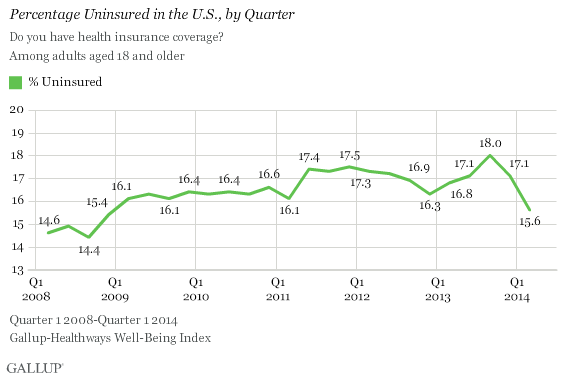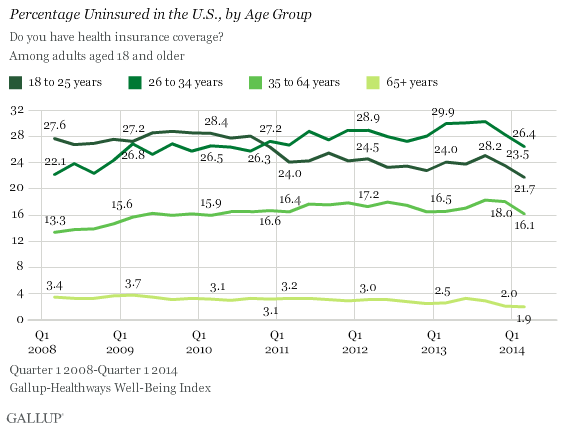WASHINGTON, D.C. -- In the U.S., the uninsured rate dipped to 15.6% in the first quarter of 2014, a 1.5-percentage-point decline from the fourth quarter of 2013. The uninsured rate is now at the lowest level recorded since late 2008.

The uninsured rate has been falling since the fourth quarter of 2013, after hitting an all-time high of 18.0% in the third quarter -- a sign that the Affordable Care Act, commonly referred to as "Obamacare," appears to be accomplishing its goal of increasing the percentage of Americans with health insurance coverage. Even within this year's first quarter, the uninsured rate fell consistently, from 16.2% in January to 15.6% in February to 15.0% in March. And within March, the rate dropped more than a point, from 15.5% in the first half of the month to 14.5% in the second half -- indicating that enrollment through the healthcare exchanges increased as the March 31 deadline approached.
The results from the first quarter are based on more than 43,500 interviews with U.S. adults from Jan. 2 to March 31, 2014, as part of the Gallup-Healthways Well-Being Index.
Fewer Americans Across Age Groups Uninsured in 2014
The Obama administration has made young adults' enrollment in a health insurance plan a top priority, as healthcare experts say 40% of new enrollees must be young and healthy for the Affordable Care Act to be successful. However, Gallup's quarterly trends indicate the uninsured rate dropped by about the same amount among adults aged 26 to 64 as it did among those aged 18 to 25 -- two points. The uninsured rate among 18- to 25-year-olds fell to 21.7% in the first quarter; the rate fell to 26.4% among those aged 26 to 34, and to 16.1% among those aged 35 to 64.

While the Department of Health and Human Services' April Enrollment Report has not yet been released, Gallup's findings correspond with the government's last report, showing only 25% of new enrollees as of Feb. 28 were in the 18-to-34 age range.
Uninsured Rate Falls Most Among Lower-Income Americans and Blacks
The uninsured rate for every major demographic group declined in the first quarter of 2014. The uninsured rate for lower-income Americans dropped 3.2 points to 27.5% -- the largest decline within any key subgroup -- while the uninsured rate for blacks fell 3.3 points to 17.6%. Hispanics remain the subgroup most likely to lack health insurance, with an uninsured rate of 37.0%, though their rate dropped 1.7 points in the first quarter.

Implications
The uninsured rate fell 1.5 percentage points to 15.6% over the last quarter, as the open enrollment period to purchase healthcare coverage through the state and federal marketplaces closed on March 31. This quarterly figure represents the average percentage of adults without health insurance since provisions requiring Americans to have insurance established by the Affordable Care Act went into effect on Jan. 1 of this year. The current figure as of today is likely lower given that uninsured rates declined throughout the quarter, including in late March.
President Barack Obama announced on April 1 that 7.1 million Americans have signed up for health insurance plans through federal and state-run marketplaces. This figure includes a late surge in consumers signing up for coverage at the end of March, as HHS reported that as of Feb. 28, only 4.2 million Americans had signed up for plans. In fact, the healthcare exchanges experienced such an influx of insurance-seeking consumers over the last week of the enrollment period that the federal exchange site HealthCare.gov had to undergo maintenance to handle the traffic.
The Obama administration also announced that Americans unable to sign up by March 31 could request an extension through April 15, which could further drive down the uninsured rate in the second quarter of 2014. Additionally, other provisions of the healthcare law have not yet gone into effect, such as the requirement for employers to provide health insurance to their employees by 2015. These provisions also may affect the uninsured rate over time.
Moreover, Medicaid has likely added millions to its enrollment due to its expansion, although -- as with the exchanges themselves -- it remains unclear how many were previously insured and moved to Medicaid as a less expensive option. Regardless, the decline in the percentage of uninsured over the course of the first quarter almost certainly includes the effects of expanded Medicaid eligibility policies. It is also likely, in turn, that not all new enrollees will ultimately pay their insurance premiums, which would result in a subsequent change in status from insured to uninsured at some point later in 2014.
Gallup will continue to track the U.S. uninsured rate in the months ahead.
EDITOR'S NOTE: The estimates of the uninsured rates in the first half and the second half of March in the text have been changed from earlier publication.
Survey Methods
Results are based on telephone interviews conducted as part of the Gallup-Healthways Well-Being Index survey Jan. 2-March 31, 2014, with a random sample of 43,562 adults, aged 18 and older, living in all 50 U.S. states and the District of Columbia.
For results based on the total sample of national adults, the margin of sampling error is ±1 percentage point at the 95% confidence level.
Interviews are conducted with respondents on landline telephones and cellular phones, with interviews conducted in Spanish for respondents who are primarily Spanish-speaking. Each sample of national adults includes a minimum quota of 50% cellphone respondents and 50% landline respondents, with additional minimum quotas by time zone within region. Landline and cellular telephone numbers are selected using random-digit-dial methods. Landline respondents are chosen at random within each household on the basis of which member had the most recent birthday.
Samples are weighted to correct for unequal selection probability, nonresponse, and double coverage of landline and cell users in the two sampling frames. They are also weighted to match the national demographics of gender, age, race, Hispanic ethnicity, education, region, population density, and phone status (cellphone only/landline only/both, and cellphone mostly). Demographic weighting targets are based on the most recent Current Population Survey figures for the aged 18 and older U.S. population. Phone status targets are based on the most recent National Health Interview Survey. Population density targets are based on the most recent U.S. census. All reported margins of sampling error include the computed design effects for weighting.
In addition to sampling error, question wording and practical difficulties in conducting surveys can introduce error or bias into the findings of public opinion polls.
For more details on Gallup's polling methodology, visit www.gallup.com.
